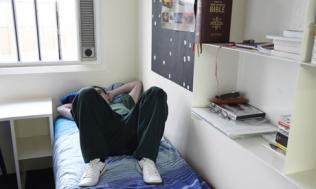A behaviour management expert gives ten reasons not to send problem pupils out of school
teenage prisoner in Ashfield Prison, near Bristol. Many young offenders have been permanently excluded from multiple schools before ending up in prison. Photograph: Andy Hall for the Guardian
The pupils we permanently exclude from school are very often damaged children. You know the ones. Not the children who test the boundaries a little, but the ones who regularly burst with anger, the ones who tell you to " *** off", the ones who run away, the ones who throw stuff at you. Their trust with the adult world has been broken at home and they bring the symptoms of their fractured childhood into school with them.
We used to call children who couldn't write "stupid" and stand them in the corner. Now we give them what they need to succeed. We used to call children who have been damaged by raw emotional trauma "bad" and then tell them that they don't belong. We still do. Some schools prefer to imprison children in "isolation booths" and make them feel that they are alone with their problems. I meet children who have spent more than 30 days a year in isolation. Children who need to talk to someone are silenced or shunned.
How is it that a headteacher in Speke in Liverpool for 23 years never excluded a pupil and another school in the South is running at more than 350 fixed term exclusions per year? Certainly the Head had to work hard to win the arguments in the wider community. To convince parents to take a risk and convince teachers that even the angriest child was better off in school than running with street gangs. But where are our common values? Where is the consistency?
Exclusion is not just a postcode lottery, it can be the school next door that is chucking them out while you are trying to keep them close. I travel the country working with PRUs and schools who want to improve behaviour. It is obvious that for some schools exclusion is simply the next step on the punishment ladder. The deregulation of schools and alternative provision only makes the inconsistencies easier to hide. As the gaps widen so do the holes in the system and children are silently falling through.
I met six young offenders last week who had been permanently excluded 38 times between them. All were under nine years old when they were first asked to leave school. I am not saying that that excluded children automatically end up in custody, but it certainly adds to the feeling that you don't belong. We seed our communities with children who have been convinced they don't belong. They spend the next 20 years telling everyone and anyone who will listen how terrible school (and specifically your school) is. So the cycle continues.
We know how to reduce exclusion. There are examples of outstanding practice all around. Reducing exclusion starts in individual classrooms with emotionally resilient teachers. Teachers who understand that they cannot solve problems by simply passing them to someone else.
Teachers who know that they can profoundly influence the behaviour of others by deliberately changing their own. Teachers who know that dangling damaged children off the cliff edge is not only futile, but cruel.
Schools that reduce exclusion understand that you can't scare the fearless into changing their ways. They truly understand the importance of relationships, they know that some children follow the rules and some only follow people.
Of course there is excellent practice out there. There are schools where exclusion is not a doorway to the cliff edge. Schools that use small increments in their sanctions steps and those who develop more productive consequences at the end of the road. Schools that provide meaningful, well supported alternative curriculums with the most emotionally resilient teachers.
The tragedy is that I still hear some teachers baying for exclusion in retribution for the child's "crimes". They want to give them "what they deserve" and not what they need.
Paul Dix · guardian.co.uk
Τελευταία νέα
- EUROPALSO - Εγκύκλιος 27/06/2025: Απογραφή ΚΞΓ – Νέο Πρόγραμμα ΔΥΠΑ για εργαζόμενους και ανέργους – Εξετάσεις Ενηλίκων – WaterFun WaterPark – Βεβαιώσεις Σπουδών Society – Νέες Παροχές για ΚΞΓ ESB – Απενεργοποίηση κωδικών E-Europalso – Υποχρεώσεις Ιουλίου-Αυγούστου 2025
- EUROPALSO - ΦΟΡΟΛΟΓΙΚΕΣ ΥΠΟΧΡΕΩΣΕΙΣ ΙΟΥΛΙΟΣ & ΑΥΓΟΥΣΤΟΣ 2025
- EUROPALSO - Νέο Πρόγραμμα ΔΥΠΑ – Με επιδότηση €750
- EUROPALSO: Προσωπικός Αριθμός – Τι Είναι – Πως Εκδίδεται
- EUROPALSO - φορολογικές υποχρεώσεις ιούνιος 2025
- EUROPALSO: Απογραφή υφιστάμενων αδειών ΚΞΓ <75 σε πληροφοριακό σύστημα OpenBusiness έως 1/12/2025
- EUROPALSO Εγκύκλιος 13/06/2025: Απογραφή ΚΞΓ σε OpenBusiness – WaterFun WaterPark – Βεβαιώσεις σπουδών για ΚΞΓ Society – ESB Online Exams for Adults – Νέες Παροχές για ΚΞΓ ESB – Advisory Offices – Υποχρεώσεις Ιουνίου 2025
- Δωρεάν Webinar: Partners in...Creativity! Transforming EFL through Human - AI Collaboration
- 1st Burlington Community Festival: ΔΩΡΕΑΝ για εκπαιδευτικούς και μαθητές 10/5 - Ίδρυμα Σταύρος Νιάρχος
- EUROPALSO Εγκύκλιος 29/04/2025: Απογραφή ΚΞΓ σε OpenBusiness – ESB Online Exams for Students, Κυριακή, 1/6 – ESB Online Exams for Adults – Νέες Παροχές για ΚΞΓ ESB – Advisory Office – Βεβαιώσεις σπουδών – Τουρνουά Σκάκι, 10/5 – Υποχρεώσεις Μαΐου, Νέα ωρομίσθια




